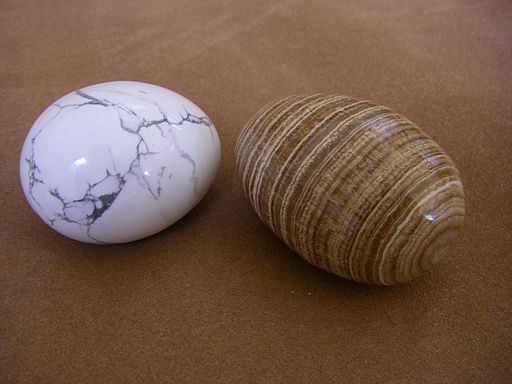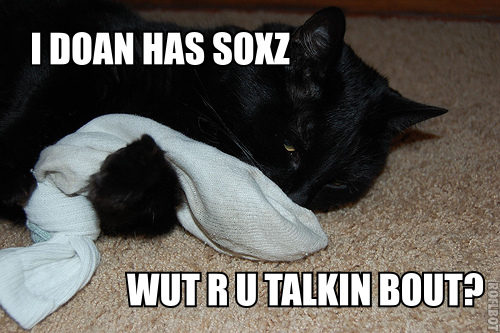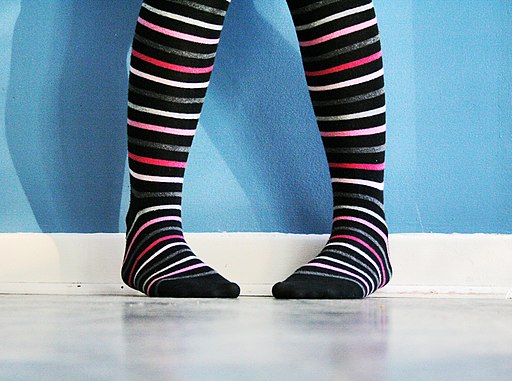Following on from what to do with a single ugly sock, today we have what to do with a matching pair of much-loved or simply useful socks which have holes in them: Darning. More traditional than ‘wocksidermy but less dramatic.
In honour of Lost Sock Memorial Day (May 9th) I decided to finally get around to darning my out-of-action bed/boot socks. (One of the downsides of having small feet is having to wear thick socks to make your boots fit – I refuse to wear children’s boots. The other downside is the pascals.)
Darning is a grand old tradition in the spirit of “use it up, wear it out, make it do, or do without” – or possibly the spirit of “I spent ages knitting those socks, I’m not going to get rid of them just because there’s a worn bit!” (Full disclosure: these particular socks are machine-made; there hasn’t been enough time for me to wear out a pair since I finally learned how to knit them.)
I was, however, somewhat hampered by not having one of these:
They’re stone darning eggs (although I suspect the one on the right of having at some point in history been part of a tree). I don’t have a darning mushroom, either, although most of the ones I’ve come across seem suited for Big Manly Feet – i.e. would stretch my socks out of all proportion.
The Internet contains a variety of suggestions as to what one could substitute for a darning egg or mushroom. These include a baseball bat (don’t have one), a lightbulb (don’t have the nerve), a lemon (don’t really need a sewn-in deodorizer that size) or a plastic Easter egg (what’s the point of an Easter egg that isn’t made of chocolate?).
So instead of an egg, I used an egg timer in the shape of a chicken. Darning is one of the few areas in which I think we can be certain the egg came before the chicken. Darning aside, I usually fall on the chicken side of the debate, because if the egg came first, who would incubate it?
I used two different sorts of darning – one traditional, one not – but I will spare you the sight of the results. There’s enough ugliness in the world as it is. Instead, have a gratuitous cat picture.
Well, not quite gratuitous – this is a leading cause of a) missing sock syndrome and b) holes in socks, after all.
On the sock which actually had a hole in it, I used the traditional cross-hatching darn, something like this:

Not that neat and tidy, obviously, particularly considering I was using it on a knitted item.
Verdict: time-consuming and boring to do, but durable and uses relatively little yarn. Also less obvious as a mend – assuming you use a yarn that matches (I didn’t).
I had seen a mention somewhere of a crocheted darn for socks which doubles as reinforcement. I can’t crochet (yet) so on the other sock, which was merely working up to having a hole, I did a running stitch around the worn patch and then used that as a base for blanket stitch. Around and around I went until the stitches were close enough to meet.
Verdict: uses a lot of yarn, but less time than traditional darning. More fun to do but, I suspect, less durable. Also it’s hard to hide what appears to be a very dense spiderweb slowly devouring your foot (especially if, like me, you use a contrasting yarn).
So there you have it. Go forth and love thy socks, single or paired, and don’t let a lack of actual knowledge, skill or practice put you off doing a mend on a much-loved pair you aren’t ready to let go of yet.




Regarding the egg you suspect was ex-tree: I’m not convinced.
Based on the end we can just see in the photo, it looks like the rings are centred on the axis of the egg. This would be possible if it was taken from the very centre of the trunk (or branch, I guess), sharing its axis with the tree’s axis.
But in that case, you’d expect the surface of the egg near its equator to be from just one or two of the tree’s rings, giving the appearance of a wide band on the surface there. We’d also expect each other ring to appear twice on the egg, once on each side of the equator; I don’t see the symmetry I’d expect if this was the case.
On the other hand, if the rings that appear on the egg are actually the result of layers in a rock, with the egg’s axis perpendicular to the layers, we’d expect the surface near the ends of the egg to be from just one or two of the layers, giving the appearance of wide rings there. This is what we actually see.
So I’m picking that the rings are from flat layers in a rock, not from cylindrical tree rings, unless it was a really big tree, so that the rings near the outside of the trunk were approximately flat layers anyway (and surprisingly close together, unless that’s a really big darning egg). I wonder what Mum thinks.
The stripy socks, on the other hand …
“We’d expect each other ring… we’d expect the surface near the ends…” – being rather free with your we, aren’t you?
Not all have your incisive, analytical mind, alas. Some of us see something round, brown and grained and go “aha! fossilized tree egg!” (not to be confused with a fertilized tree egg, which is more usually called a seed and isn’t so useful for darning unless you want a tree growing out of your sock).
You are probably right, but I wouldn’t stress the point too heavily until you learn to darn your own socks 🙂
It was the “editorial we“ I’m used to writing in mathematical contexts. (Best quote from Halmos’s paper: “”We thank our wife for her help with the typing” is always bad”.)
I did wonder if I should have signed the comment Summer Glau, but only in the sense of it being an unnecessarily detailed analysis, not in the sense of it being in response to a particularly stupid comment.
Besides, you were meant to say something like “Those stripy socks are clearly being worn on feet, not hands”.
We thank you for not thanking your wives for their support when writing your thesis. We think.
Huh! I thought I was the last person in the world darning socks. I too do it without particular skill, in fact I had no idea those stone eggs had anything to do with darning! But you know men and their big toes…I believe I’ve saved us a fortune in socks alone.
Yay! It’s not just me!
Although I have to admit I’m horrified at how much quicker my socks wear out than my husband’s – perhaps the sock manufacturers assume that women are more eager to move on to something new, whereas men like to wear the same garment until it dies of extreme old age.
Or perhaps they just don’t make them like they used to…
Yeah, I dunno, but I’m willing to hold the motives of sock manufacturers suspect. All my favourite stripey odd socks have holes that are just so far beyond the reach of darning. ..It’s going to cost me a fortune to replace them!